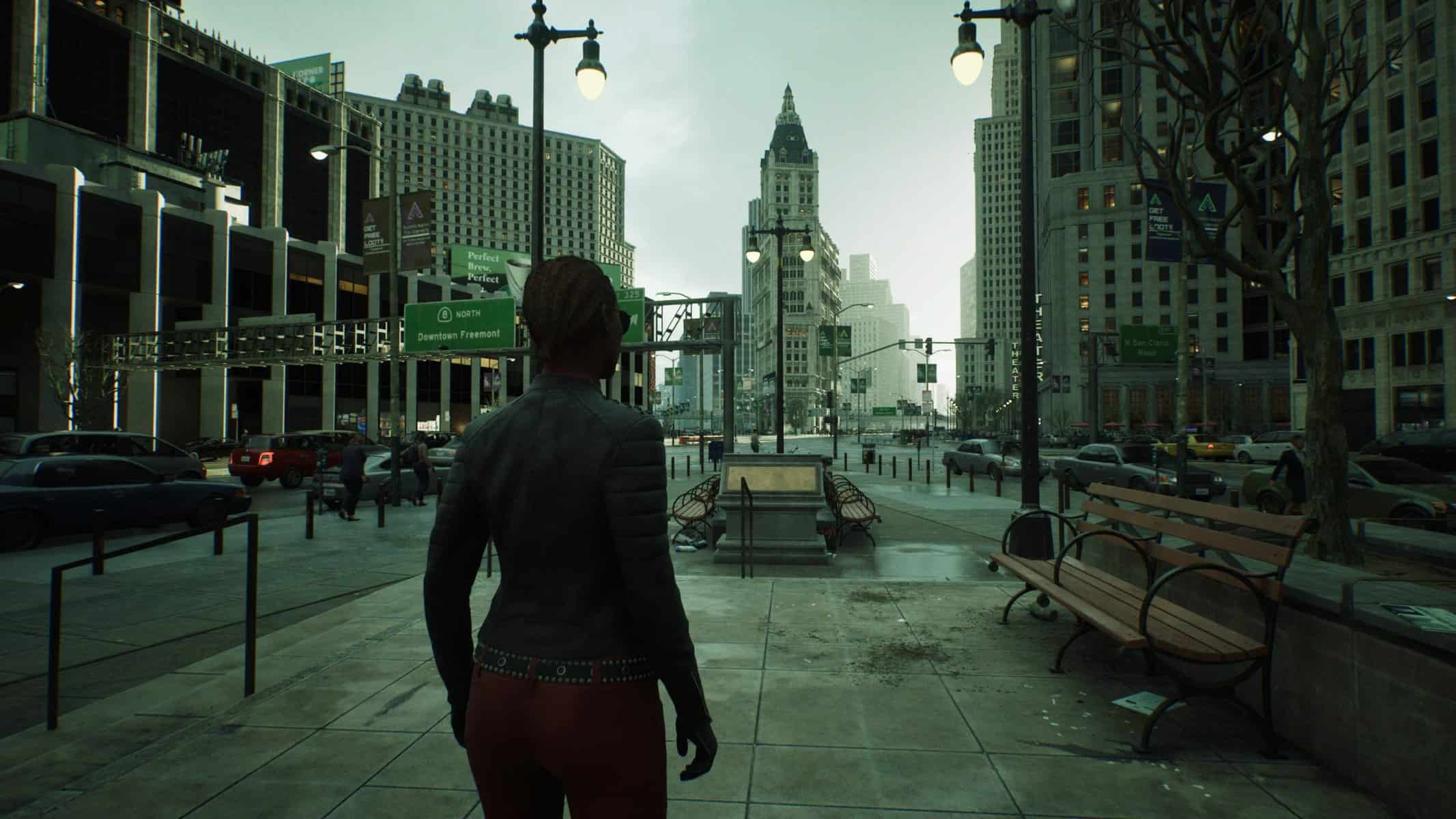You can trust VideoGamer. Our team of gaming experts spend hours testing and reviewing the latest games, to ensure you're reading the most comprehensive guide possible. Rest assured, all imagery and advice is unique and original. Check out how we test and review games here
The Matrix Awakens, or, to give it its full title, The Matrix Awakens: An Unreal Engine 5 Experience, is upon us. If you have a PlayStation 5 or either of the two newer Xboxes, you can download it, free of charge, and boot the Matrix from its studio-mandated slumber. Should you choose to do so, you will be treated first to the breathtaking spectacle of Keanu Reeves’s face. “In an industry where actors have tried to remain perpetually young, we wondered about digital faces that could become immortal,” he says. So there you have it. If you, too, have wondered how Reeves’s face has managed to repel the attacks of time, like Neo raising his palm to a shoal of incoming bullets, here is your answer: Some time around 1999, he went digital. The real and wrinkled Reeves is plugged into a machine somewhere, and we have been watching the unreal ever since.
I regret to report that The Matrix Awakens is not solely concerned with Keanu Reeves’s face. I had hoped for a Reevesian update on the title screen of Super Mario 64, for which Nintendo (emboldened not by Unreal Engine 5 but by the Nichimen N-World toolkit) presented us with Mario’s newly three-dimensional visage. It hung there, waxy and pendulous, waiting to be spun, pinched, and pulled in different directions. If Reeves had draped himself from nose to nape in a web of motion-capture markers and submitted to our prodding—perhaps throwing in the occasional “Whoa!”—we could be talking Game of the Year material.
As it happens, we get a citybound car chase, richly lathered in crunched metal and crying rubber, and capped off with an on-rails gunfight. Then, we are treated to a drone’s-eye-view of the metropolis, as day dims into night, and the surfaces are stripped away to reveal the tessellating polygons beneath—a city of stained-glass windows. Finally, we are deposited into this open world, free to explore—and to find a series of plaques on which the developers at Epic Games have engraved a number of tidbits about the powers of their new toy. For example, we are informed that there are “45,073 parked cars, of which 38,146 are drivable and destructible,” and that there are “12,422 manhole covers.” Doubtless, this will be immensely reassuring to those players who happen to work in sanitation and are fed up with the so often improper attention paid to virtual sewage maintenance.
Having spent entirely too much time playing The Matrix Awakens, I have come to the conclusion that it is a perfect chunk of software. Not perfect in the mechanical sense: the driving, for instance, puts me in mind of Mouse, from the first film, when he muses on the verities of Tasty Wheat: “How do the machines really know what Tasty Wheat tasted like, huh? Maybe they got it wrong.” Indeed, I am convinced that the machines got driving here confused with dodgems. Not only do the vehicles emit an engineless whir, as though they were quaffing electrical current from the floor, but the crashes have a hollow plasticity to them; and the camera lags and lurches behind your movements like a trailer bolted onto your back fender, providing the familiar slosh of seasickness that attends any trip to the funfair.
No, the perfection of The Matrix Awakens is in its conception, and the way it is coolly encased in irony. During the early chase, as Neo and Trinity slice through an intersection in a muscle car of oleaginous black, they talk about the need for “some sexy action” to offset the “theoretical mumbo-jumbo” and appease the marketing people. “Marketing? I thought we were supposed to have total creative control,” says Neo. To which Trinity replies, “Welcome to the Matrix.” In other words, what we have is a simulation of a simulation: a technical showcase for Unreal Engine 5, for which a city has been conjured from a churning sea of code, which is simultaneously the subject of its fiction—the synthetic but, crucially, convincing world of the Matrix itself.
We should also note that The Matrix Awakens is not here to promote an upcoming game. Thus, it joins the ranks of other closed-circuit pleasures, such as P.T.—whose endless hallway has, since the cancellation of Silent Hills, somehow grown more, not less, complete. It brings to mind, too, the tech demo for what would have been the third Getaway game, entitled “The Getaway Future Vision,” from 2005. It was never playable, and it entailed nothing more than a detached camera, wafting airily around a rendered Piccadilly Circus as it was beetled by midday traffic—a stream of unreal engines, broken here and there by the bright, double-decked red of a passing bus. But I still need to be picked up off the floor whenever I watch that video.
And so to the masterstroke of The Matrix Awakens, which comes courtesy of a button prompt labelled “Fly.” This is not, as you might assume—or pray—the kind of crouched-down, trench-coat-rippling affair that we get in the movies, but something more placid. The camera unhooks from its perch, leaving your character behind, and, taking after that London tourist, you can do as much airy wafting as you please. Your mind is free. Welcome to the Matrix. Whatever the marketing people may fear, Epic Games has given us a place where the theoretical mumbo-jumbo is the sexy action. Behold the settings menu, where you can alter the density of vehicles, like an urban Moses pedestrianising the Red Sea. You can even rid the air of its greenish tint—though I prefer to keep it. And if you wish to see the A.I. routines that govern the roads show up as queues of glowing dots, like gridlocked fireworks, have at it.
The question, posed by a graceful and graphically pristine Carrie-Anne Moss, is “What would reality mean when a world we can build feels as real as our own?” The answer is “I’m quite sure I don’t know, and I’m afraid that this one doesn’t yet.” But it matters not; verisimilitude isn’t the true coup of The Matrix Awakens. Its purpose may well be to show off the possibilities of Unreal Engine 5, and, early on, I wouldn’t blame anyone for being agog and thinking, What would happen if Rockstar got a hold of this? But that, ultimately, is to do a disservice to what is in front of us. True, it’s fun to envision somewhere like this overlaid with a story and peopled with authentic characters—to imagine its detail dirtied with purpose. But look around: the city is an authentic character, and that has less to do with its 12,422 manhole covers and more to do with its defining style, which we might call Unrealism.
One of the eeriest moments in games this year came as I drifted toward a group of gossiping skyscrapers. The wind moaned between the concrete, and I drove the camera, at a steady pace, toward their peaks. Who needs a car chase? Where old games like Enter the Matrix and The Matrix: Path of Neo—guilty thrills, both—gave us the martial arts, the wall-running, and the slippages of slow motion, this one gives us something else. Whether or not Unreal Engine 5 can whip up a convincing reality, the real wonder of The Matrix Awakens is that it delivers an utterly convincing unreality. In short, it delivers the Matrix. Can you dodge bullets? No, but, when you’re ready, you won’t want to.
The Matrix Awakens
- Platform(s): PlayStation 5, Xbox Series S, Xbox Series S/X, Xbox Series X
- Genre(s): Adventure, Shooter, Simulation




